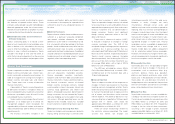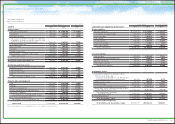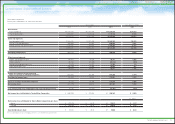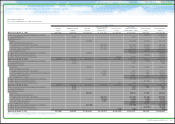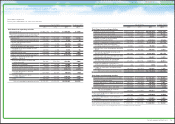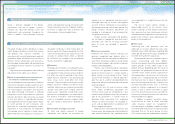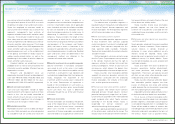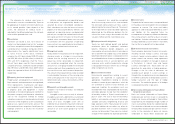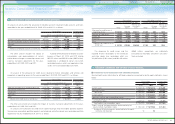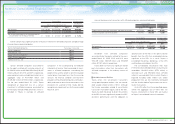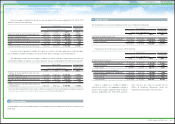Toyota 2011 Annual Report Download - page 79
Download and view the complete annual report
Please find page 79 of the 2011 Toyota annual report below. You can navigate through the pages in the report by either clicking on the pages listed below, or by using the keyword search tool below to find specific information within the annual report.
U.S. dollar amounts:
3
Supplemental cash flow information:
4
Acquisitions and dispositions:
5
0822
Financial Section and
Investor Information
Business and
Performance Review
Special FeatureMessage/Vision
Management and
Corporate Information
Notes to Consolidated Financial Statements
share, except that the weighted-average number
of shares outstanding includes the additional
dilution from the assumed exercise of dilutive
stock options.
Toyota measures compensation expense for its
stock-based compensation plan based on the
grant-date fair value of the award, and accounts
for the award.
Other comprehensive income refers to revenues,
expenses, gains and losses that, under U.S.GAAP
are included in comprehensive income, but are
excluded from net income as these amounts are
recorded directly as an adjustment to shareholders’
equity. Toyota’s other comprehensive income is
primarily comprised of unrealized gains/losses on
marketable securities designated as available-
for-sale, foreign currency translation adjustments
and adjustments attributed to pension liabilities or
minimum pension liabilities associated with
Toyota’s defined benefit pension plans.
In June 2009, FASB issued updated guidance of
accounting for and disclosure of transfers and
servicing. This guidance eliminates the concept
of a qualifying special-purpose entity, changes
the requirements for derecognizing financial
assets, and requires additional disclosures about
transfers of financial assets. Toyota adopted this
guidance from the fiscal year ended March 31,
2011. The adoption of this guidance did not have
a material impact on Toyota’s consolidated
financial statements.
In June 2009, FASB issued updated guidance
of accounting for and disclosure of consolidation.
This guidance changes how a company determines
is effective for the interim period or the fiscal year
beginning on or after June 15, 2011, and shall be
applied retrospectively to the beginning of the
fiscal year of adoption. Management does not
expect this guidance to have a material impact on
Toyota’s consolidated financial statements.
when a variable interest entity should be
consolidated. Toyota adopted this guidance from
the fiscal year ended March 31, 2011. The adoption
of this guidance did not have a material impact on
Toyota’s consolidated financial statements.
In July 2010, FASB issued updated disclosure
guidance on receivables. This guidance requires
additional disclosures about the credit quality of
financing receivables and the allowance for credit
losses. Toyota adopted this guidance from the
fiscal year ended March 31, 2011. The adoption of
this guidance did not have a material impact on
Toyota’s consolidated financial statements. For a
further discussion of additional disclosures by
adoption of this guidance, please see notes 7 and
11 to Toyota’s consolidated financial statements.
In October 2009, FASB issued updated guidance
of accounting for and disclosure of Revenue
Recognition with Multiple Deliverables. This
guidance allows the use of estimated selling price
for determining the selling price of deliverables,
eliminates the residual method of allocation and
expands the disclosures related to a vendor’s
multiple-deliverable revenue arrangements. This
guidance is effective prospectively for revenue
arrangements entered into or materially modified
in fiscal year beginning on or after June 15, 2010.
Management does not expect this guidance to
have a material impact on Toyota’s consolidated
financial statements.
In April 2011, FASB issued updated guidance
to clarify the accounting for and disclosures about
troubled debt restructurings by creditors. This
guidance provides the criteria as to whether a
loan modification constitutes a troubled debt
restructuring and requires additional disclosures
about troubled debt restructurings. This guidance
Certain prior year amounts have been reclassified
to conform to the presentations as of and for the
year ended March 31, 2011.
Accounting changes
Reclassifications
U.S. dollar amounts presented in the consolidated
financial statements and related notes are
included solely for the convenience of the reader
and are unaudited. These translations should not
be construed as representations that the yen
amounts actually represent, or have been or
Cash payments for income taxes were ¥563,368
million, ¥(207,278) million and ¥211,487 million
($2,543 million) for the years ended March 31,
2009, 2010 and 2011, respectively. Interest
payments during the years ended March 31,
2009, 2010 and 2011 were ¥614,017 million,
During the years ended March 31, 2009, 2010 and 2011, Toyota made several acquisitions and disposi-
tions, however the assets and liabilities acquired or transferred were not material.
could be converted into, U.S. dollars. For this
purpose, the rate of ¥83.15 = U.S. $1, the approxi-
mate current exchange rate at March 31, 2011,
was used for the translation of the accompanying
consolidated financial amounts of Toyota as of
and for the year ended March 31, 2011.
¥445,049 million and ¥382,903 million ($4,605
million), respectively.
Capital lease obligations of ¥28,953 million,
¥3,400 million and ¥10,478 million ($126 million)
were incurred for the years ended March 31,
2009, 2010 and 2011, respectively.
Stock-based compensation
Other comprehensive income
Recent pronouncements to be adopted in
future periods
79TOYOTA ANNUAL REPORT 2011


